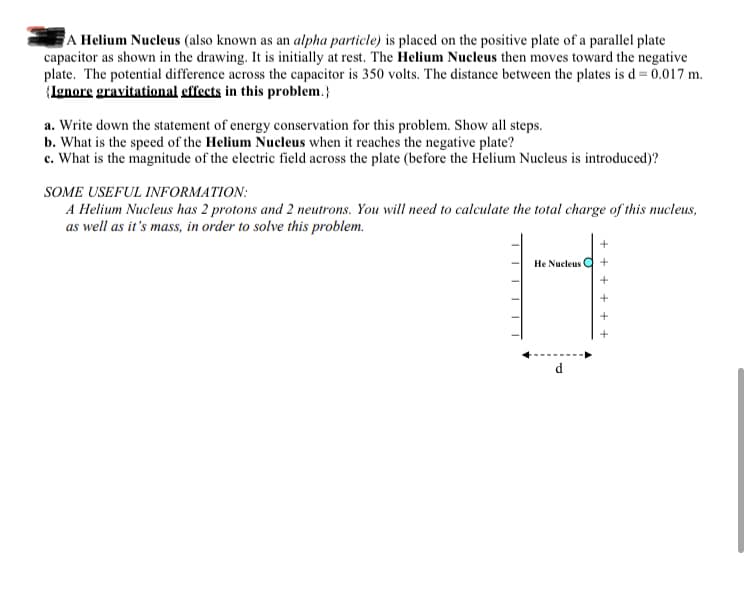A Helium Nucleus (also known as an alpha particle) is placed on the positive plate of a parallel plate capacitor as shown in the drawing. It is initially at rest. The Helium Nucleus then moves toward the negative plate. The potential difference across the capacitor is 350 volts. The distance between the plates is d= 0.017 m (Ignore gravitational effects in this problem.} a. Write down the statement of energy conservation for this problem. Show all steps. b. What is the speed of the Helium Nucleus when it reaches the negative plate? c. What is the magnitude of the electric field across the plate (before the Helium Nucleus is introduced)? SOME USEFUL INFORMATION: A Helium Nucleus has 2 protons and 2 neutrons. You will need to calculate the total charge of this nucleus, as well as it's mass, in order to solve this problem.
A Helium Nucleus (also known as an alpha particle) is placed on the positive plate of a parallel plate capacitor as shown in the drawing. It is initially at rest. The Helium Nucleus then moves toward the negative plate. The potential difference across the capacitor is 350 volts. The distance between the plates is d= 0.017 m (Ignore gravitational effects in this problem.} a. Write down the statement of energy conservation for this problem. Show all steps. b. What is the speed of the Helium Nucleus when it reaches the negative plate? c. What is the magnitude of the electric field across the plate (before the Helium Nucleus is introduced)? SOME USEFUL INFORMATION: A Helium Nucleus has 2 protons and 2 neutrons. You will need to calculate the total charge of this nucleus, as well as it's mass, in order to solve this problem.
Related questions
Question
Should question A be
PEi + KEi = PEf + KEf
PEi + 0 = 0 + KEf
qV = 1/2 m (Vf)^2? I’m not sure if it right please explain

Transcribed Image Text:A Helium Nucleus (also known as an alpha particle) is placed on the positive plate of a parallel plate
capacitor as shown in the drawing. It is initially at rest. The Helium Nucleus then moves toward the negative
plate. The potential difference across the capacitor is 350 volts. The distance between the plates is d= 0.017 m.
(Ignore gravitational effects in this problem.}
a. Write down the statement of energy conservation for this problem. Show all steps.
b. What is the speed of the Helium Nucleus when it reaches the negative plate?
c. What is the magnitude of the electric field across the plate (before the Helium Nucleus is introduced)?
SOME USEFUL INFORMATION:
A Helium Nucleus has 2 protons and 2 neutrons. You will need to calculate the total charge of this nucleus,
as well as it's mass, in order to solve this problem.
He Nucleus Q
d
+ +
Expert Solution
This question has been solved!
Explore an expertly crafted, step-by-step solution for a thorough understanding of key concepts.
Step by step
Solved in 2 steps
